Recycled Stone – Christianized Art in Athens
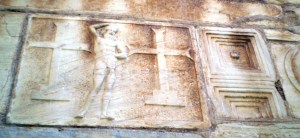
While this practice seems unthinkable today, across the Mediterranean, ancient Greek and Roman structures were salvaged for building materials in subsequent centuries. Given the prevalence of the Catholic Church in the Middle Ages, pagan buildings were at best a curiosity. The Parthenon in Rome is said to have only survived because it was converted into a church.
The Pentelic marble used to construct ancient Athens proved to be too alluring for Byzantine builders. You can see blatant example of stone theft in the piece-meal construction of the 13th century Panagia Gorgoepikoos Church in Athens. While the materials were stolen, the care with which pieces were selected and incorporated suggests some appreciation for classical art.
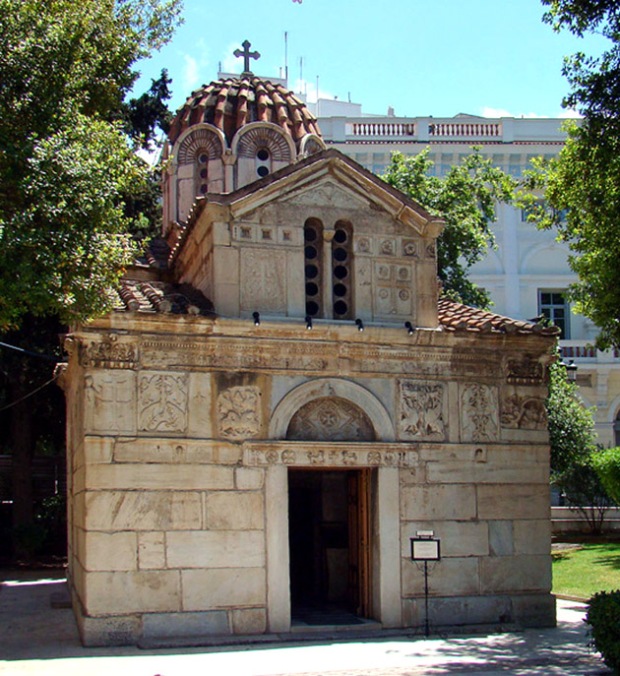
13th Century Panagia Gorgoepikoos (The Madonna who Quickly Hears) Church, Athens (Image adapted from the web)
The small Panagia Gorgoepikoos Church sit about 50 feet from the Mitropolit Cathedral in the Plaka region of Athens. It would be easy to discount the little building, but don’t be fooled. This Byzantine cross-in-square church has a quirky decorative narrative worth a long look. When constructed in the 12th century, stone from classical Greek, Roman, Christian and early Byzantine buildings* were incorporated into the facade of the church along with newly carved elements. Placement is a little haphazard with only a moderate attempt at symmetry or a coherent aesthetic. What’s most impressive when examining the exterior is that all the decorated panels have essentially been preserved and are used in a way that recognizes that each is valuable, if not also beautiful. Some panels though just needed a “Christianization”:
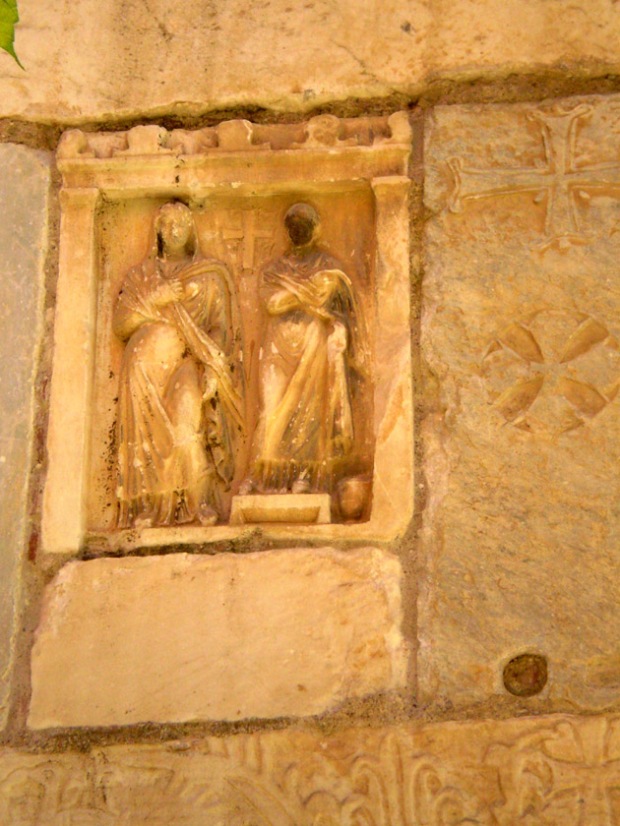
Roman funerary monument converted to acceptable Christian decor with the addition of a carved cross. Facade of the Panagia Gorgoepikoos Church, Athens
Given the framing and poses of the two figures above, the stone was likely removed from a Roman funerary monument. Interestingly, to make the panel suitable for a church, only a small cross sized to the available space was carved between the figures. If the builders had wanted to desecrate the pagan images, they could easily have broken the figures faces which we don’t see here. (The face on the right has been stained but is intact.)
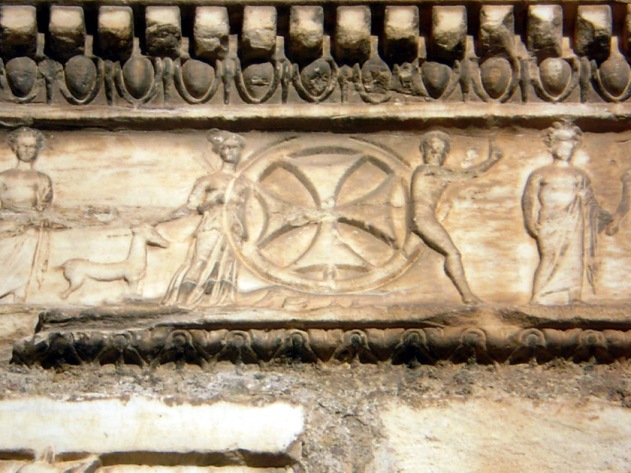
4th century BC Greek frieze with added 13th century cross on the exterior of Panagia Gorgoepikoos Church, Athens
One register above the main door, running the length of the front facade, is a long Classical frieze reported to be from the 4th century BC. The carving is beautiful; I only wish I could figure out what legends it depicts. (You can see more of the frieze here.) I love that it was selected for such a prominent visual position. Obviously a cross was inserted over some of the carvings but this was done very carefully and deliberately. Neither Diana(?) with her stag or Mercury(?) were obliterated. I think the sculptors recognized the value of this carving and purposefully sought it out for the church’s entrance.
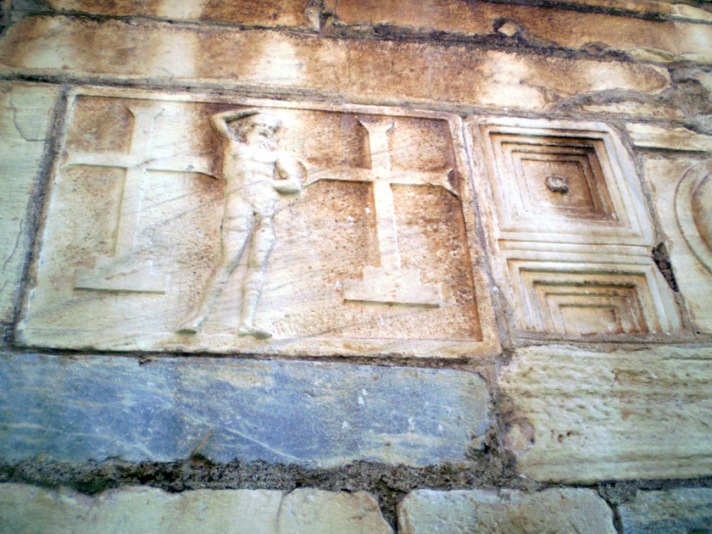
Christianized Classical male nude along the side facade of the Panagia Gorgoepikoos Church in Athens
I love this part of wall! Here on the right we see two coffered ceiling tiles, I suppose inserted for ascetic reasons. Then, a classical male nude is made church-appropriate by adding two large crosses beside him. The crosses are recess carved, so the stone worker would have removed a thin layer of stone up to and around the male figure without disturbing his outline. There didn’t appear to be a huge gash taken out of the man, as one might expect, to censor his nakedness so this imagery was presumably not an issue for the 12th century builders. (On the other hand, time may have worn him down so the nudity wasn’t an issue by the time the panel was installed.)
It’s hard to tell when exactly the crosses were added to each panel: in the 4th century upon the adoption of Christianity in the Roman Empire to deface existing art or in the 12th century while preparing for construction of Panagia Gorgoepikoos Church. In the panel above, we see a partial classically modeled man and a Patriarchal Cross. This cross with a second upper horizontal element is a unique Byzantine style that didn’t appear until the 10th century. This suggests that panel selection and the incorporation of crosses did not occur until the construction of the Panagia Gorgoepikoos Church.
Just to show that the facade really is a hodge-podge of carved elements, there are beautiful Byzantine animals panels (birds, lions, griffins, deer) incorporated throughout the exterior. The image above shows the back of the church with a Byzantine lion killing a leopard. At the very top corner, along the roof line you can see another Roman panel of two figures into which a cross has been carved between them. What I find most interesting in the large panel with carved circles. Given the placement of the Greek text on this stone, this reminds me of Medieval grave markers in which a stone slab would have been used to cover a burial plot.
Overall, the Panagia Gorgoepikoos Church is a cool place to explore and a great find for lovers of art history. While small in size, it illustrates the complex relationship between the Byzantines and the remnants of the Greek and Roman civilizations. While I have seen Classical works defaced and damaged by later inhabitants, the builders of the Panagia Gorgoepikoos Church appear to have respected and sought out quality art, whether it was Christian or pagan in origin.
*Before the 12th century building that stands today, there was a 7th century church on this site. It’s not clear how much of the exterior, or even interior decorative elements, were taken from that building.






Reblogged this on Art History Ramblings.
LikeLike
Nice post!
LikeLike
So interesting to see the mix of influences and such old art still in good condition.
LikeLike
Definitely the mix of influences, styles and time-periods is striking. I think that’s what drew me to the exterior of the church.
LikeLike
very, very interesting. Terrific post, well researched and on a fascinating topic. Thank you.
LikeLike
Thanks Arran! I appreciate the feedback. I’ve saving your St. Patrick’s Cathedral posts for when I can focus best on reading. Looking forward to them!
LikeLike
No problem, my pleasure. As for my own recent histories, yes, I don’t blame you waiting, I entirely appreciate they’re on the long side and require a bit of a time-investment. Hope you do find time at some stage and, if so, hope you find it worth while. If not, no pressure, life is for enjoyable reading & learning definitely, but also for living. very best regards – Arran.
LikeLike